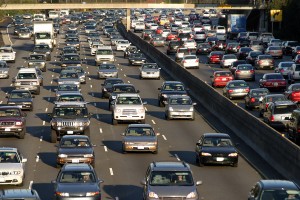The morning and afternoon commutes are a hellacious experience to the average driver: gas, brake, honk and frustration are the common themes between 6 a.m. and 10 a.m. and 5 p.m. and 7 p.m. If you thought the commuting experience would improve then you might be in for some disappointment.
Rocky Moretti, director of policy and research at transportation researcher The Road Information Program (TRIP), spoke with CNNMoney and said that traffic will likely worsen as the United States economy improves and people return to the workforce. This means that the average driver will spend additional wasted hours in traffic.
Since transportation is a major economic hub for growing the economy then it’s likely that drivers, cyclists, bikers and pedestrians will notice roads filled up more with people and modes of transportation.
 “That was one way to deal with congestion – have a recession,” said Moretti. Economic growth is starting to pick up. That’s obviously a very positive trend, but you do need the transportation system to accommodate that growth.”
“That was one way to deal with congestion – have a recession,” said Moretti. Economic growth is starting to pick up. That’s obviously a very positive trend, but you do need the transportation system to accommodate that growth.”
According to TomTom’s 2014 traffic study, Los Angeles, San Francisco, Honolulu, Seattle, San Jose and New York were the most congested American cities in 2013. In fact, traffic had actually increased in the aforementioned cities, while Los Angeles reached its highest level in five years: LA drivers spent 40 additional minutes every day dealing with clogged freeways, which amounts to 90 hours, or more than 11 work days, per year.
Although this might be considered bad to the average American commuter, Moscow has topped the list of worst cities to commute in as the average driver loses an estimated 16 work days a year to the constant stop-and-go traffic.
The report found that Tuesday is the worst morning commute of the week, while Thursday is the worst commute to head home. All of this comes with a cost as well: drivers forked over more than $800 in extra costs, including fuel.
Is there a solution to this traffic madness? Moretti suggested that municipalities can approve a series of measures to improve traffic, such as road management with better signs and signals, constructing new roads and enhance reliance on public transportation. Of course, according to the study authors, the economy is improving faster than the government can produce new roads.
Forbes published an article earlier this year that looked at how society can improve the traffic experience while also boosting productivity. The report analyzed the self-driving vehicle that can also offer a flexible workplace. For instance, Regus, a workspace provider, partnered up with Rinspeed to develop the XchangE concept car, which maintains two seats that swivel backwards to initiate a mobile work and meeting space for up to four individuals with a detailed infotainment system.
“A consultant or sales rep could fit in seven to eight hours of productive work each day, using a driverless vehicle,” Andre Sharpe, Regus’ global product and business development director, told the business news publication. “This innovative car will change wasted time into productive time.”
It’ll be a long time before companies develop reliable driverless vehicles. It’ll be some time until the problems of intense traffic congestion is resolved. In the meantime, commuters will just have to prepare themselves for more years of gas, brake, honk, punch.



